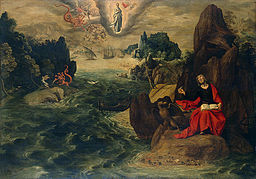 In January of this year, I finished a seven-year project. In retrospect, it seems more like a journey than a project. I would like to describe a few aspects of my journey in hopes that I can share some of the insights that I have gained.
In January of this year, I finished a seven-year project. In retrospect, it seems more like a journey than a project. I would like to describe a few aspects of my journey in hopes that I can share some of the insights that I have gained.
1. My initial book idea and how that transformed into a commentary. During my studies at Trinity, I became interested in Revelation due to a PhD seminar and my focus on Johannine studies. As I began teaching, I developed four lectures on Revelation that provided an overview of the entire book. After I finished That Scripture Might Be Fulfilled: Typology and the Death of Christ, I began to think about what to do next. Students in my classes suggested to me that an elaboration of my notes would make a helpful book. I also noticed that many of my professor friends wanted to identify themselves as adherents to historic premillennialism. However, in conversations with them, I could detect uncertainty about how to interpret certain aspects of Revelation from this perspective. So, I set about writing a short guide to the book of Revelation, perhaps something around 200 pages. Given my interests, I wanted the guide to help people relate Revelation to the Old Testament, to Johannine theology, and to explore the strengths and weaknesses of a historic premillennial approach to the book.
After I went down this path for about 2 years, I began to realize that I did not understand the book well enough to complete this project. I changed my approach and began to work through the book in a more verse by verse fashion. As I did this, I could see that I was starting to write a commentary and not a short guide to the book. After 4 more years, I had covered most of the book of Revelation and was ready to go back and shape up my original work so that I would have a full commentary
2. A few rewards of wrestling with the book of Revelation. The process of writing a commentary on various passages forced me to deal with questions that I had glossed over in my lectures and lecture notes. Again and again, I realized how superficial my treatment of various issues had been. For example, I had to figure out the structure of the book, including the place of the 21 plagues in that structure. I also began to realize that the chronology of the 21 plagues was not something that I could avoid making a decision about. When do they take place? How much overlap is there among them? Could I explain the literary and chronological progression for the 7 seals, 7 trumpets, and 7 bowls?
I had to wrestle with the different views on the book and how that would affect my view of the proper way to interpret certain passages. For example, Babylon sits on seven hills. Is that reference simply all about the fact that Rome sits on seven hills (preterist view)? Or is it also about worship of the Beast and idolatry, since Babylon, who worships the Beast and encourages such worship, sits on seven mountains while God’s city, the New Jerusalem, sits eternally on one mountain, Mount Zion (14:1, 21:10)? The number seven in Revelation so commonly has to do God or with imitation of God. A great ungodly city with seven hills is a city that appears to be staking a claim to be as great and as powerful as God’s city.
To be continued… I will continue my reflections on writing about Revelation in my next post.
